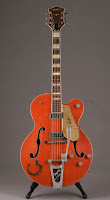 This is the meaning of life
This is the meaning of life
To tune this electric guitar
--Talking Heads, “Electric Guitar”
According to Dik de Heer’s exhaustive In the Can page, on Friday, January 15, 1960, rock guitarist Duane Eddy completed the recording of his acoustic album Songs of Our Heritage, a strong candidate for rock music’s first “unplugged” album. Eddy, known for his “twangy” guitar—a 1956 Gretsch model 6120, aka a “Chet Atkins Hollow Body” (an example of this particular 1956 production model is pictured above)—had been extraordinarily successful with a series of rock instrumental albums in the late 1950s, beginning with the colossal best-seller, Have ‘Twangy’ Guitar—Will Travel, which entered the charts in January 1959 and remained there for the next 42 weeks. With Songs of Our Heritage (Jamie Records, 1960), he unplugged, performing a number of American folk tunes, including “John Henry,” “Streets of Laredo,” “Wayfarin’ Stranger,” “Mule Train,” and others.
Duane Eddy, along with guitarists such as Link Wray (who in contrast to Eddy’s “twangy” guitar played a “fuzzy” or distorted guitar) and, later, Dick Dale, eroticized the electric guitar, transforming it into a hypermasculine symbol of phallic power. Eddy’s “Rebel Rouser” and Wray’s “Rumble” were much more than rock instrumentals featuring the electric guitar: the guitar became a signifier of masculine rebellion. (There’s a direct link, for instance, from Wray’s “Rumble” to Steppenwolf’s “Born to be Wild,” as both are “biker” favorites.) The Who’s Pete Townshend has said that he was compelled to learn the guitar because of Link Wray’s “Rumble.” Likewise, John Fogerty of Creedence Clearwater Revival said he picked up the guitar because of the bold image of Duane Eddy standing before his band, his authority determined by the fact that he wielded the scepter-like electric guitar. In retrospect, Jimi Hendrix’s act of setting his guitar on fire at the end of his performance at the Monterey Pop Festival seven years later seems not so much a “sacrifice” in the ritual (religious) sense as it is an act of self-emasculation. Sigmund Freud would no doubt be compelled to explore the question as to why no guitar heroes in rock music have ever been female. He'd probably give the same answer as he did in Civilization and Its Discontents in his speculations as to why women are no good with baseball bats.
The album cover of Songs of Our Heritage reveals the extent to which rock musicians (and hence rock music) consciously or unconsciously identified itself 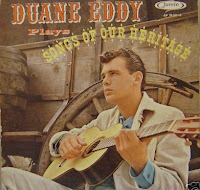 with a certain set of distinctive values (among them, the American frontier) all of which helped distinguish it from Pop. According to Mike Jarrett’s wonderful Sound Tracks: A Musical ABC, Vols. 1-3 (Temple University Press, 1998), a book I find myself returning to again and again, rock music has defined itself against pop by a number of associations derived from the signifer of the guitar. I’ve only listed a few of these structural oppositions here from Jarrett’s more comprehensive list (pp. 68-69 in his book):
with a certain set of distinctive values (among them, the American frontier) all of which helped distinguish it from Pop. According to Mike Jarrett’s wonderful Sound Tracks: A Musical ABC, Vols. 1-3 (Temple University Press, 1998), a book I find myself returning to again and again, rock music has defined itself against pop by a number of associations derived from the signifer of the guitar. I’ve only listed a few of these structural oppositions here from Jarrett’s more comprehensive list (pp. 68-69 in his book):
ROCK/POP
guitars/keyboards
frontier/civilization
experience/knowledge
rural/urban
masculine/feminine
spontaneity/calculation
genuine/artificial
raw/cooked
America/Europe
vigorous/effete
To which one might “hard” and “soft,” as in “hard rock” vs. “soft rock” (i.e., “pop,” sometimes derisively referred to as “bubblegum,” the later associated with “boys” or "boy bands" rather than “men.”) The symbolic underpinnings of this structural opposition hardly need to be made explicit.
In response to what I anticipate to be the many objections the psychoanalytic approach I’ve employed here, I’ll simply point out the way certain American filmmakers subsequently appropriated this music for the aural backdrop in films exploring hypermasculine violence (its later use proves the point). Oliver Stone used “Rebel Rouser” in Natural Born Killers, while Quentin Tarantino used Dick Dale’s “Misirlou” and Wray’s “Ace of Spades” and “Rumble” in Pulp Fiction. And David Lynch has used the so-called “dirty boogie” inspired by Link Wray for songs such as “Blue Frank." Have a listen "Blue Frank," included on the Twin Peaks: Season 2 soundtrack, that was used in Fire Walk With Me during the Partyland scenes, the corresponding sonic counterpart to scenes of eroticized violence.
Saturday, February 16, 2008
Friday, January 15, 1960: Electric Guitar
Monday, February 11, 2008
Thursday, January 14, 1960: The Pale Gaze
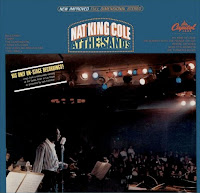
Nat “King” Cole’s album At the Sands was recorded live on January 14, 1960 at the Sands Hotel and Casino in Las Vegas. At the time of Cole’s concert, the Sands’ Copa Room was the place where one might see a so-called “summit” or ensemble performance of the “Rat Pack,” a group of entertainers (Frank Sinatra, Dean Martin, Sammy Davis, Jr., Peter Lawford, Joey Bishop, et al.) whose extravagant lifestyle was characterized by real or symbolic (makes no difference) excess: the American Dream realized through dissipation. A popular singer, Cole--having long since surrendered his primary identity as a jazz pianist--performed at the Sands for a white audience that for well over a decade had associated him with “The Christmas Song” (“Chestnuts roasting over an open fire...”). The Sands concert exhibits a range of musical styles that allowed Cole to highlight the mellower inflections of his voice; he sang some old hits and some old standards, including ballads (“I Wish You Love”), the blues (Cole Porter’s “Miss Otis Regrets,” W. C. Handy’s “Joe Turner Blues”), Rodgers & Hart (“Thou Swell,” “Where or When”), and Rodgers & Hammerstein (“The Surrey With the Fringe on Top”), variously arranged by Nelson Riddle, Pete Rugolo, and Dave Cavanaugh.
Hence the Sands show seems to have followed the format of Cole’s 1956-57 television show that had been cancelled slightly over two years earlier. As Krin Gabbard explains in Jammin’ at the Margins: Jazz and the American Cinema (University of Chicago Press, 1996): “Throughout the run of his [television] program, Cole was surrounded by white performers playing “white” music, most notably vocal groups such as the Boateneers and the Cheerleaders and an orchestra led by Nelson Riddle. And on many episodes he was surrounded by groups of all-white dancers and singers.” Perhaps most importantly, observes Gabbard, the TV show’s producers “had numerous strategies for containing his sexuality, at some points playing up his status as a family man....More often than not, Cole was photographed from the waist up in much the same way that Elvis Presley’s lower body was concealed when he appeared on the Ed Sullivan Show, an event that took place during the run of Cole’s own television show. Although, in a sense, Cole was the inverse of Presley--a restrained black man acting “white” rather than a shameless white man acting “black”--NBC felt a need to conceal his hips in the same way that CBS attempted to censor Presley” (246). Moreover, Cole’s significant film career, argues Gabbard, was consistently characterized by attempts to neutralize the exotic allure of “a sexually attractive black male whose singing voice had already been the source of fantasy for many of his listeners” (245).
By “neutralize the exotic allure” I mean the attempt to utterly repress the (forbidden) possibility of interracial sex--that is, the lure of transgressive sex. The album cover of At the Sands would seem to do just that: it consists of a photograph (presumably) taken during the actual concert, in which Cole, illuminated by the glare of the spot lights, stands at the microphone, smiling, confident, and relaxed. Behind him is the largely white orchestra; in front, looking on, the white audience, barely visible in the smoky shadows beyond the edge of stage. The photograph would seem to be nothing more than just what it is, a snapshot taken the night of January 14, 1960 of a Nat “King” Cole concert: since he’s the star, of course he’s on the album cover. The cover is simply an unadorned moment frozen in time, perhaps stereotypical of such things, a picture of a highly popular singer on stage in concert benignly recorded for posterity. Nothing like, for instance, the presumably “lurid” album cover of Tabu, an album featuring the music of Ralph Font and His Orchestra, released by Westminster Records just a few months prior to Cole’s Sands concert.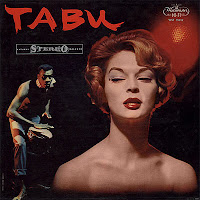
And yet, they both depict the same scene. The earlier cover, Tabu, makes explicit what is (almost) concealed in the later cover. Following Eric Lott, Michael Jarrett, in Sound Tracks: A Musical ABC, Vols. 1-3 (Temple University Press, 1998) calls this concealment the phenomenon of the “pale gaze,” a gaze “motivated by the lure of transgressive sex--the bliss promised by miscegenation”(254). Both album covers enact a scene depicting “White eyes watching objectified and sexualized black bodies” (254).
Even so, Jarrett would have a problem with my argument if I would end the analysis having provided only these two instances of album art as my examples, because the minstrel model, the operation of which I’ve explained here, “expresses white interests alone, even if only to castigate and, ultimately, atone for those interests” (254). Like all models of “cooptation,” says Jarrett, the minstrel model “ignores, discounts, or represses the possibility of reciprocity. White fantasies and desires don’t just prey upon black fantasies and desires, they also feed them. They’re reciprocal, forming a feedback loop.” Instead of a minstrel model, what is needed is a minstrel cycle, a model which can account for “mutually defining desire” (254-55). British music critic Simon Frith explains the minstrel cycle in this way: “white youth becomes an object of black pleasure exactly to the degree that the recurring fantasy of being black is coded into white style, white anxiety, white posture” (Village Voice, 3 September 1991, p. 78). The virtue of the minstrel cycle over the minstrel model, Jarrett argues, is that race can be seen, not as “one of the raw materials from which culture is produced,” but rather one of the “byproducts” of a “complex social machine” (255).  The operation of the minstrel cycle explains how Nat “King” Cole became, as Krin Gabbard puts it, “one of the few black actors who functioned [in a few significant films] essentially as a white hero,” although to do so he “had to surrender a good deal of his masculine presence and sex appeal." The reciprocal example? Gabbard uses white actor Hoagy Carmichael, whose screen persona was irrevocably altered by his association with African American musicians. He “ended up playing parts that could just as easily have been played by blacks” (240).
The operation of the minstrel cycle explains how Nat “King” Cole became, as Krin Gabbard puts it, “one of the few black actors who functioned [in a few significant films] essentially as a white hero,” although to do so he “had to surrender a good deal of his masculine presence and sex appeal." The reciprocal example? Gabbard uses white actor Hoagy Carmichael, whose screen persona was irrevocably altered by his association with African American musicians. He “ended up playing parts that could just as easily have been played by blacks” (240).
Monday, February 4, 2008
Wednesday, January 13, 1960: Haley's Comet(s)
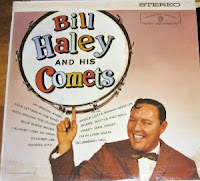 In yesterday's blog I referred to Albert Goldman's controversial biography Elvis (1981). Having mentioned the book, I was prompted to return to it and re-read the portions relevant to Elvis's army career, and found that, contrary to the general perception many have of the book, Goldman demonstrated a good deal of empathy for Elvis's predicament at the time he was drafted and that he also made some important observations. For instance:
In yesterday's blog I referred to Albert Goldman's controversial biography Elvis (1981). Having mentioned the book, I was prompted to return to it and re-read the portions relevant to Elvis's army career, and found that, contrary to the general perception many have of the book, Goldman demonstrated a good deal of empathy for Elvis's predicament at the time he was drafted and that he also made some important observations. For instance:
For from Elvis's viewpoint, he had nothing to gain from the army and everything to lose. At the time he entered the service, he was at the very peak of his fame. With fads and fashions in pop music changing constantly, with a host of imitators and rivals springing up to steal his stuff, with fame itself such a freaky and chancy thing, what likelihood was there that he could come back two years hence and pick up exactly where he left off? There was none; and, in fact, Elvis never did regain the momentum he lost when he entered the army. So, from Elvis's point of view, his conscription was the worst sort of disaster that could have befallen him as an entertainer and a new star. (324 Avon paperback edition).
Thus it seems appropriate that on the very day Elvis and his service buddies traveled to Paris on leave, January 12, Bill Haley and His Comets were at Bell Sound Studios in New York City recording material that would be used on two albums for Warner Brothers released in 1960: Bill Haley and His Comets (pictured above) and Bill Haley's Jukebox. According to Chris Gardner's authoritative Bill Haley sessionography, on January 13, 1960 Bill Haley and the Comets were re-recording their signature tune, "(We're Gonna) Rock Around the Clock" for Warner Brothers, as well as "Stagger Lee" and, ironically, "Blue Suede Shoes," the earlier hit for Elvis. Of course, all these songs might be considered rock and roll "standards" as it were, but the juxtaposition of these two seemingly unrelated events, one happening in Paris and the other New York, bears out Goldman's argument that while Elvis was in the army, rock and roll (and popular music) was blithely moving on without him.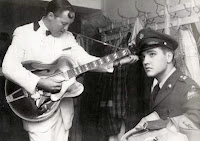 Despite the fact that the two albums of material released in 1960 by Bill Haley and His Comets are comprised largely of covers, in retrospect they were significant releases, as the previous year Warner Brothers Records had begun to take the steps which, by the end of the 1960s, transformed it into a major label with a significant popular music catalog. The Bill Haley and His Comets recording sessions for Warner Brothers were produced by the formidable George Avakian, an important figure in American recording history and an especially important figure in jazz music. He had joined Warner Brothers the year before with the specific task of building its pop music catalog, and among the first acts he convinced to move to WB was Bill Haley and His Comets. (Avakian also signed The Everly Brothers and comedian Bob Newhart.) Prior to moving formally to Warner, Avakian had been asked to produce Tab Hunter's first WB single, "Jealous Heart," which became the label's first charted single. Of course, Tab Hunter was never a serious rival to Elvis, but the point is clear enough: while Elvis was in the army, any number of figures were found to replace him. Perhaps those figures weren't as talented as Elvis, but the point is that among his achievements what Elvis created was a set of performance possibilities, the "opening up" of styles of performance, so it really didn't matter whether those figures were equally talented.
Despite the fact that the two albums of material released in 1960 by Bill Haley and His Comets are comprised largely of covers, in retrospect they were significant releases, as the previous year Warner Brothers Records had begun to take the steps which, by the end of the 1960s, transformed it into a major label with a significant popular music catalog. The Bill Haley and His Comets recording sessions for Warner Brothers were produced by the formidable George Avakian, an important figure in American recording history and an especially important figure in jazz music. He had joined Warner Brothers the year before with the specific task of building its pop music catalog, and among the first acts he convinced to move to WB was Bill Haley and His Comets. (Avakian also signed The Everly Brothers and comedian Bob Newhart.) Prior to moving formally to Warner, Avakian had been asked to produce Tab Hunter's first WB single, "Jealous Heart," which became the label's first charted single. Of course, Tab Hunter was never a serious rival to Elvis, but the point is clear enough: while Elvis was in the army, any number of figures were found to replace him. Perhaps those figures weren't as talented as Elvis, but the point is that among his achievements what Elvis created was a set of performance possibilities, the "opening up" of styles of performance, so it really didn't matter whether those figures were equally talented.
Of course, none of these historical developments answer the daunting question asked by Albert Goldman in his biography of Elvis: "As to the question of why the Colonel should have urged Elvis to interrupt his career at its peak in order to join an army that was in no hurry to draft him, we find ourselves up against one of the most baffling questions posed by Colonel Parker's mysterious machinations." (328) Perhaps the Colonel believed that no one could "copy" or "imitate" Elvis, and that is true (although there were those that tried, but were unsuccessful), but the successful ones who followed him didn't try to copy him, but used the opportunities Elvis gave them to create their own styles of performance. Perhaps that is what the Colonel did not see or understand was possible when he stopped Elvis's career dead in its tracks.
Sunday, February 3, 2008
Tuesday, January 12, 1960: Parisian Romp

I've never been able to shake the impression that Elvis's year and a half in Germany (October 1958-March 1960) while a soldier in the U. S. Army had a sort of surreal quality to it. Arriving in Bremerhaven on October 1, 1958 and met by approximately 1,500 unruly fans, Der Elvis must have experienced a sense of deja vu, believing for a moment he was back in America. Soon after his arrival, he boarded a train to Friedberg, northeast of Frankfurt, where he and the other members of the Thirty-second Tank Battalion, Third Armored Division, were installed in the austere, grey-bricked Ray Barracks which, about twenty years earlier, had been the barracks of Hitler's S. S. troops.
"I'd like to meet Brigitte Bardot," Elvis had said while still in America, on the day he departed for Germany, and perhaps he'd meant it, because twice he used the opportunity that extended leave gave him to visit Paris. Apparently he never met Brigitte Bardot, but in addition to meeting lots of cute German girls, while on leave Der Elvis also met many cute French girls. Peter Guralnick, in Careless Love: The Unmaking of Elvis Presley (Little, Brown, 1999) said that while in Germany Elvis had other sorts of encounters as well, having met "pills that a sergeant had introduced him to when they were on maneuvers at Grafenwöhr" (p. 21). Guralnick goes on to write on the same page that one time one of Elvis's service buddies observed Elvis exchange some "'large bills'" for "over four quart-size bottles of amphetamines....When Elvis returned to the car, he said with a wink, 'Rexadus, it ain't what you know but who you know that counts in this old world.' And Rex couldn't help but think, 'And if you got lots of money it helps.' "
Albert Goldman, author of the much-maligned (read: mythbusting) biography Elvis (McGraw-Hill, 1981) isn't quite so sure that Elvis was first introduced to amphetamines in Germany, believing that this explanation is nothing but an expression of the old "innocence corrupted" myth--the inevitable Platonic apocalyptic sequence of deviation from the Good--that fans hold on to about their cherished King. I tend to agree with Goldman: there's no evidence that Elvis did not use amphetamines prior to entering the Army--his mother's use of "weight loss" pills is well documented--and well-known Memphis figures Elvis knew before entering the service, such as Dewey Phillips, allegedly got by with a little help from their friends.
According to Peter Guralnick and Ernst Jorgensen's Elvis Day By Day (Ballantine, 1999), on Tuesday, January 12, 1960, Elvis traveled with his friends Joe Esposito, Cliff Gleaves, and his new found friend and recently hired karate instructor, Jurgen Seydel--"the father of German karate"--to Paris. Required to return to the base by Sunday, Guralnick reports the second trip to Paris was "much the same" (p. 49) as the first trip to the city of lights, meaning an amphetamine-fueled nighttime trip fantastic, in which Der Elvis careened "from one improbable fantasy to another" (34). The Parisian romps anticipated his life-to-come in America after returning from exile in Germany:
They woke up late in the day to have their one full meal, a huge 8:00 p.m. breakfast. Then they would catch the first show at the Carousel or the Folies Bergère, and from there go on to the Lido, where the statuesque chorus line, the Blue Belles, were all English girls eager to make Elvis Presley's acquaintance. After the Lido closed, they would proceed to Le Bantu, a late-night club which didn't open until 4:00 a.m., bringing with them as many of the Blue Belles as wanted to come along. At the end of the evening Elvis would take his pick from among all the girls, leaving the rest for [the others] to choose from. (34)
Returning from his second trip to Paris on Sunday, January 17, Elvis had just about seven weeks left in the Army. He would return to America late on the evening of March 2, and three days later, on March 5, the King would be formally discharged from the service. Hence, on January 12, his army nightmare was just about over, but Elvis's image would be irrevocably altered (perhaps intentionally) during his absence, and his cultural influence effectively over. As John Lennon is supposed to have remarked upon hearing of Elvis's death in 1977: "Elvis died the day he went into the army."
Saturday, January 26, 2008
Monday, January 11, 1960: Cold Shower

According to author Stephen Rebello, in his extremely interesting and well-researched book, Alfred Hitchcock and the Making of Psycho (St. Martin's Griffin, 1998, p. 138), on January 8, 1960, director Alfred Hitchcock sent a memo to his sound men, Waldon O. Watson and William Russell, giving them explicit instructions about the role of sound in the shower scene. Surprisingly, no mention is made of music. We can safely assume, I think, that the (now famous) shower scene of Psycho was being edited--though was certainly not completed--on Monday, January 11, 1960. The premiere of the film was slightly over five months away.
The title of Rebello's book about the film is carefully worded, because it is clear that Alfred Hitchock cannot take full credit for the success of Psycho--indeed, his role in post-production was virtually non-existent. Revealingly, after screening a rough cut of the film, Hitchcock himself thought the film was terrible, and considered cutting it down and salvaging it by showing it as an episode of Alfred Hitchcock Presents. The achievement of Psycho, such as it is, seems in retrospect to have been the result of two factors: the extremely talented artists with which Hitchcock surrounded himself--first and foremost, film editor George Tomasini, the aforementioned sound designers, Waldon O. Watson and William Russell, and composer Bernard Herrmann--and the first generation of American critics (e. g., Andrew Sarris) who had adopted the assumptions and perspectives of the auteur theory. The achievement of the film itself is largely a technical one; its status as a "classic" is largely a discursive one, Hitchcock having pride of place as the first movie director bestowed the imprimatur of auteur. What was Romanticism in the nineteenth century was called Modernism in the twentieth, and like all Modernists, Hitchcock took to heart the principle of the self as art, and ran with it. (I highly recommend Robert E. Kapsis's book, Hitchcock: The Making of a Reputation, University of Chicago Press, 1990.)
The French New Wave critics who had disseminated and promoted the auteur theory through the journal Cahiers du Cinema—Francois Truffaut, Eric Rohmer, Claude Chabrol and Jean-Luc Godard—had one primary champion, and that was Alfred Hitchcock. Eric Rohmer and Claude Chabrol's Hitchcock was published in 1957, shortly after the release of Hitchcock’s The Wrong Man (1956), and was an early important work of auteur theory (although it remained untranslated into English for many years). The reason for Rohmer's and Chabrol's choice to champion Hitchcock most certainly was because they perceived him to be much like themselves: Catholic, politically liberal, intelligent, and Modern. However, since auteurists (at least the French ones) always had trouble with what they called a "Tradition of Quality," the auteurist position tended to champion directors who sometimes made bad films (e. g., besides Hitchcock, Otto Preminger) or were not very nice (e. g., Sam Peckinpah) or were not very intelligent (e.g., name omitted). And as one might expect, the hallowed pantheon of auteurs was also always a boy's club--the offices of Cahiers du Cinema had pin-ups on the walls well into the 1960s.
My friend Frank Mazzola, who grew up in Hollywood and eventually became a respected film editor, told me that while he was an apprentice editor in the late 1950s and early 1960s, he was a "gofer" at Universal while George Tomasini was editing Psycho and Bob Lawrence was editing Spartacus (the films were released about three months apart in 1960). Tomasini's offices were at one end of the floor and Lawrence's were at the other. Saul Bass, who created the title sequences for both films, was also there, moving between both sets of offices. While Frank saw Kubrick, he never saw Hitchcock, although Hitchcock had a office/bungalow at Universal. The famous shower sequence in Psycho was created not by Hitchcock but by Tomasini, sound designers Watson and Russell, by Bernard Herrmann's strings--and, according to Stephen Rebello, by Mrs. Hitchcock, who in her screening of the sequence was the only one of them all to notice that although she's presumably dead when she falls to the floor, Janet Leigh blinked, forcing Tomasini to insert a brief cutaway to the shower head.
I should note that Tomasini was Hitchcock's editor of choice for a decade, from Rear Window (1954) through Marnie (1964). After Tomasini's early death in November 1964 at age 55, Hitchcock made only four more films in a period of twelve years, none of which are very interesting. For whatever reason, it would seem that Hitchcock lost interest in making movies after Tomasini's death.
In retrospect, the major contribution of the French auteur theorists is that they invented film studies (and directors such as Alfred Hitchcock as well), for without the notion of the director as writer, film courses never would have been able to be offered in university English departments, which is where film studies courses were first offered. Of course, there are other reasons that contributed to rise of film studies--the collapse of university enrollments following the abolition of the draft in the early 1970s being one, but nonetheless the auteur theory was an extremely important factor in the development of film studies in the late 1960s and 1970s.
Has the significance of the shower sequence been over-emphasized in critical discussions of Psycho? For interesting discussion of that question, go here. For an excerpt from Rebello's book, as well as contemporary film reviews in addition to critical interpretations and re-assessments of Psycho, see Robert Kolker, Ed., Alfred Hitchcock's Psycho: A Casebook, Oxford University Press, 2004).
Sunday, January 20, 2008
Sunday, January 10, 1960
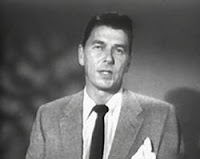 The crucial role of television to promote presidential candidates and their agendas is now an accepted truism. If this commonplace bit of wisdom is indeed true, then it should come as no surprise that three future U. S. Presidents were television personalities in 1960: John F. Kennedy, Richard Nixon, and Ronald Reagan. John F. Kennedy and Richard M. Nixon, of course, were presidential candidates, but perhaps the most popularly-known figure of the three was Ronald Reagan--but not because of the "obvious" reason, that he was a movie star. In fact, at the time, Reagan was host of the highly successful television series, General Electric Theater. Broadcast by CBS on Sunday nights in the 9:00-9:30 p.m. Eastern time slot, after The Ed Sullivan Show and before Alfred Hitchcock Presents, Ronald Reagan become program host of General Electric Theater on September 26, 1954; with Reagan as host, by December of that year--three months later--General Electric Theater had entered Nielsen's Top 10 among all television programs as the most popular weekly dramatic program.
The crucial role of television to promote presidential candidates and their agendas is now an accepted truism. If this commonplace bit of wisdom is indeed true, then it should come as no surprise that three future U. S. Presidents were television personalities in 1960: John F. Kennedy, Richard Nixon, and Ronald Reagan. John F. Kennedy and Richard M. Nixon, of course, were presidential candidates, but perhaps the most popularly-known figure of the three was Ronald Reagan--but not because of the "obvious" reason, that he was a movie star. In fact, at the time, Reagan was host of the highly successful television series, General Electric Theater. Broadcast by CBS on Sunday nights in the 9:00-9:30 p.m. Eastern time slot, after The Ed Sullivan Show and before Alfred Hitchcock Presents, Ronald Reagan become program host of General Electric Theater on September 26, 1954; with Reagan as host, by December of that year--three months later--General Electric Theater had entered Nielsen's Top 10 among all television programs as the most popular weekly dramatic program.
According to William L. Bird, Jr., in an article on the program that can be found at the Museum of Broadcast Communications website,
By the time General Electric Theater concluded its eight-year run in 1962, Reagan claimed to have visited GE's 135 research and manufacturing facilities, and met some 250,000 individuals. In later years, Reagan's biographers would look back upon the tour and the platform it provided for the future President of the United States to sharpen his already considerable skill as a communicator.
The last General Electric Theater program was broadcast on May 27, 1962; four years from that date, Ronald Reagan was about five months away from being convincingly elected Governor of California (1966). Although defeated in his 1960 presidential bid, Richard Nixon would return to politics as well, and be elected President in 1968. Perhaps it is not ludicrous at all to consider the possibility that politicians and their handlers learned something from Col. Tom Parker, who used television to catapult Elvis Presley from regional success to national sensation in 1956. Indeed, the rise of Elvis corresponds to a transitional moment in media technology--the rise of television. So, too, would the political careers of future presidents correspond to the new technology of television.


